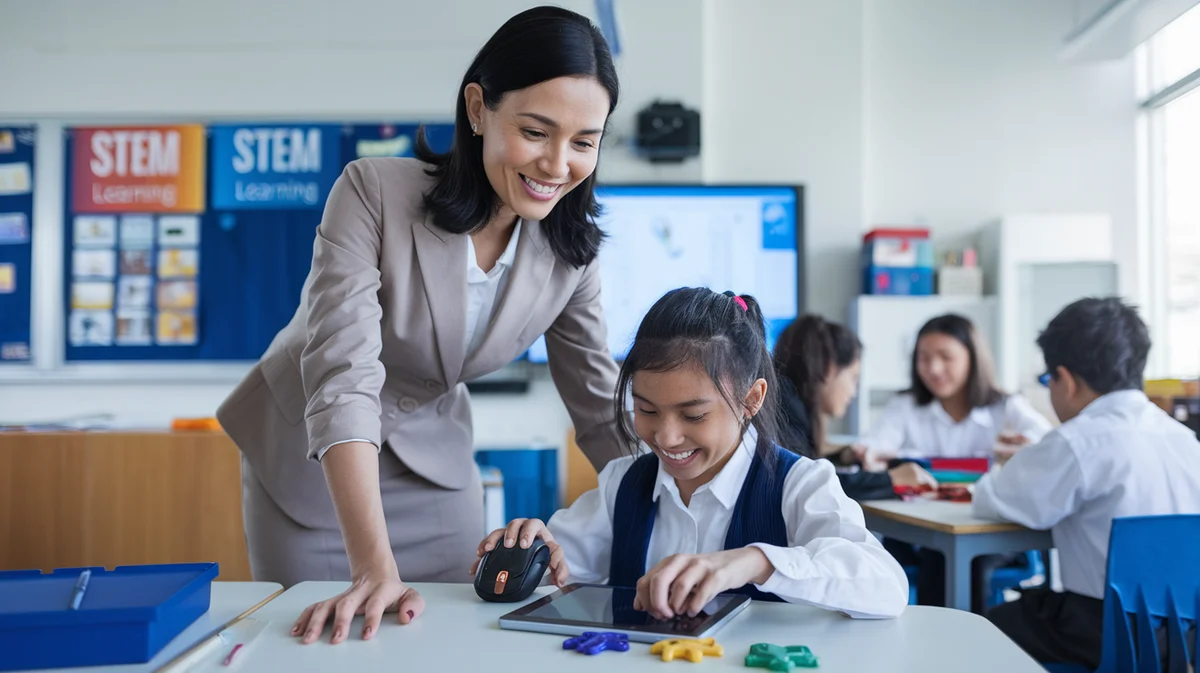EdTech and STEM Partnerships: Driving Transformative Learning Outcomes


wp:paragraph
In today’s rapidly evolving educational landscape, the synergy between EdTech and STEM partnerships is proving essential for nations striving to equip students with future-ready skills. At UNOWA, we are committed to empowering educational institutions, educators, and students through innovative, inclusive, and scalable solutions that align with national standards and global best practices. Here, we explore how strategic EdTech partnerships are transforming STEM learning outcomes across the EU, MENA, and CIS regions, drawing on the latest research, policy insights, and proven strategies.
/wp:paragraph
wp:heading {"level":2}
The Urgency: Why STEM and EdTech Partnerships Matter
/wp:heading
wp:paragraph
Recent data from the European Commission reveals a concerning trend: in 2023, 24% of EU students fell below the basic proficiency threshold in science, up from 22% in 2018 (source). This underscores persistent challenges in STEM education, including gender gaps, teacher shortages, and disparities in access to high-quality resources — especially in rural and underserved communities.
/wp:paragraph
wp:paragraph
Meanwhile, the MENA region is experiencing a surge in EdTech innovation, with governments investing heavily in digital literacy and ICT infrastructure to support STEM learning (source). In the CIS, countries like Russia and Kazakhstan leverage deep tech capabilities and robust STEM foundations to drive scalable, tech-driven learning solutions.
/wp:paragraph
wp:heading {"level":2}
The Power of Public-Private Partnerships
/wp:heading
wp:paragraph
Public-private partnerships (PPPs) are at the heart of successful EdTech and STEM partnerships. Governments and private sector EdTech firms are joining forces to deploy AI-powered platforms, virtual labs, and gamified learning tools that personalize and enhance STEM education. For example, Qatar and Bahrain have launched national digital literacy programs and invested in ICT infrastructure, improving access to STEM education and fostering innovation in teaching methods (source).
/wp:paragraph
wp:paragraph
In the EU, policy reports call for increased investment in PPPs to address teacher training, curriculum alignment, and equitable access to STEM resources. These collaborations are vital for scaling innovative solutions and bridging the digital divide.
/wp:paragraph
wp:heading {"level":2}
Teacher Training: The Cornerstone of Effective EdTech Integration
/wp:heading
wp:paragraph
No EdTech solution can succeed without well-prepared educators. Across the EU and MENA, governments are investing in upskilling teachers to effectively use digital tools and adapt to new pedagogical approaches. AI and machine learning are increasingly used to provide predictive analytics, helping teachers identify student needs and tailor instruction for maximum impact.
/wp:paragraph
wp:paragraph
As one expert notes:
/wp:paragraph
wp:quote
“Integrating artificial intelligence (AI) and machine learning (ML) into EdTech solutions is becoming increasingly prevalent... These technologies are utilized to personalize learning experiences, optimize educational content delivery, and provide predictive analytics to help educators identify student needs more effectively.” (source)
/wp:quote
wp:paragraph
At UNOWA, we offer comprehensive training and professional development programs, ensuring educators are confident and empowered to leverage the full potential of our STEM innovation solutions.
/wp:paragraph
wp:heading {"level":2}
Inclusive, Scalable, and Curriculum-Aligned Approaches
/wp:heading
wp:paragraph
Inclusivity and scalability are non-negotiable for impactful EdTech and STEM partnerships. In the MENA region, adaptive learning platforms are designed to cater to diverse student populations, including those in rural or underserved areas. The EU emphasizes curriculum alignment, ensuring digital tools support national education standards and learning objectives.
/wp:paragraph
wp:paragraph
Our MIKKO inclusive education system and Ulabs STEM innovation platform are built to be adaptable, supporting both mainstream and special education needs. This ensures every learner, regardless of background or ability, can access high-quality STEM education.
/wp:paragraph
wp:heading {"level":2}
Success Stories: Global Reform Projects in Action
/wp:heading
wp:list
- Qatar and Bahrain: National digital literacy programs and investments in ICT infrastructure have significantly improved access to STEM education, fostering innovation and preparing students for the digital economy.
- Russia/CIS: EdTech companies leverage strong STEM foundations to develop advanced learning platforms, supporting both in-class and remote education.
- EU Rural Schools: Targeted initiatives bridge the STEM proficiency gap by providing digital resources and teacher support to rural communities.
/wp:list
wp:paragraph
These examples demonstrate the transformative power of strategic EdTech and STEM partnerships, particularly when solutions are tailored to local needs and aligned with national priorities.
/wp:paragraph
wp:heading {"level":2}
Overcoming Challenges: Gender Gaps, Teacher Shortages, and Equity
/wp:heading
wp:paragraph
Despite progress, significant challenges remain:
/wp:paragraph
wp:list
- Gender gaps persist, with girls underrepresented in STEM fields, especially in the EU.
- Teacher shortages and limited access to high-quality digital resources hinder progress in rural and underserved communities.
- Curriculum alignment and scalability of EdTech solutions across diverse education systems require ongoing attention.
/wp:list
wp:paragraph
At UNOWA, we address these challenges by designing inclusive, adaptable solutions and fostering partnerships that prioritize equity and access.
/wp:paragraph
wp:heading {"level":2}
Policy and Regulatory Landscape
/wp:heading
wp:paragraph
The European Commission advocates for coordinated policy efforts, research, and investment in STEM education, with a focus on inclusivity and digital transformation (source). MENA governments are implementing national strategies to enhance digital literacy, integrate EdTech, and align STEM curricula with workforce needs. CIS countries continue to prioritize STEM in national education policies, supporting EdTech innovation and public-private collaboration.
/wp:paragraph
wp:heading {"level":2}
Recommendations from Global Reform Projects
/wp:heading
wp:paragraph
Drawing on global best practices and our own experience delivering over 300 national projects, we recommend:
/wp:paragraph
wp:list
- Invest in teacher training and professional development to ensure effective use of EdTech in STEM education.
- Foster public-private partnerships to scale innovative, curriculum-aligned digital solutions and bridge access gaps.
- Prioritize inclusivity by designing adaptive learning platforms that address the needs of diverse and underserved student populations.
- Align EdTech initiatives with national education standards and workforce requirements to maximize impact and sustainability.
/wp:list
wp:heading {"level":2}
The Future: AI, Personalization, and Data-Driven Insights
/wp:heading
wp:paragraph
The integration of AI and machine learning in EdTech is accelerating, enabling platforms to personalize STEM learning and provide actionable insights for educators. Governments in the EU and MENA are ramping up efforts to address STEM proficiency gaps, particularly in rural and marginalized communities, through targeted digital initiatives and partnerships.
/wp:paragraph
wp:paragraph
At UNOWA, we are at the forefront of these developments, continuously innovating to ensure our solutions remain future-ready and impactful.
/wp:paragraph
wp:heading {"level":2}
Frequently Asked Questions
/wp:heading
wp:heading {"level":3}
What are the key benefits of EdTech and STEM partnerships?
/wp:heading
wp:paragraph
EdTech and STEM partnerships enable scalable, inclusive, and curriculum-aligned solutions that improve learning outcomes, bridge access gaps, and prepare students for the demands of the digital economy.
/wp:paragraph
wp:heading {"level":3}
How do public-private partnerships enhance STEM education?
/wp:heading
wp:paragraph
Public-private partnerships bring together the expertise and resources of governments and EdTech firms, enabling the deployment of advanced technologies, teacher training, and curriculum-aligned content at scale.
/wp:paragraph
wp:heading {"level":3}
Why is teacher training crucial for EdTech success?
/wp:heading
wp:paragraph
Effective teacher training ensures educators can confidently use digital tools, adapt to new pedagogical approaches, and personalize instruction to meet diverse student needs.
/wp:paragraph
wp:heading {"level":3}
How does UNOWA support inclusive STEM education?
/wp:heading
wp:paragraph
We design adaptive learning platforms and inclusive education systems that cater to all learners, including those with special educational needs, ensuring equitable access to high-quality STEM education.
/wp:paragraph
wp:heading {"level":3}
Where can I learn more about UNOWA’s solutions?
/wp:heading
wp:paragraph
Visit our website at https://violet-quail-244249.hostingersite.com to explore our comprehensive range of educational systems, STEM innovation platforms, and professional development offerings.
/wp:paragraph
wp:paragraph
Empowering educators to create a brighter future for all students is at the heart of what we do. By fostering strategic EdTech and STEM partnerships, we are transforming learning experiences and shaping a more inclusive, innovative, and future-ready world.
/wp:paragraph
wp:paragraph
References:
/wp:paragraph
wp:list
- European Commission: Education and Training
- World Bank: EdTech Handbook
- UNESCO: Education for Sustainable Development
- EdTech Magazine: AI and ML in Education
- UNOWA
/wp:list








